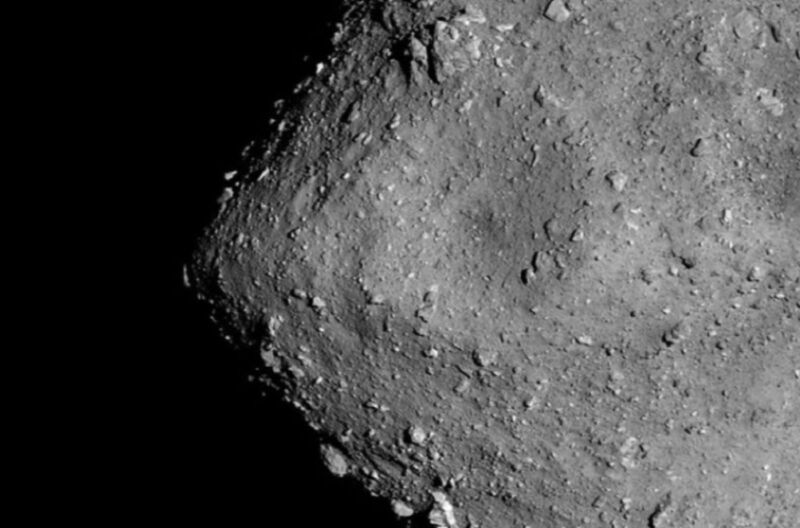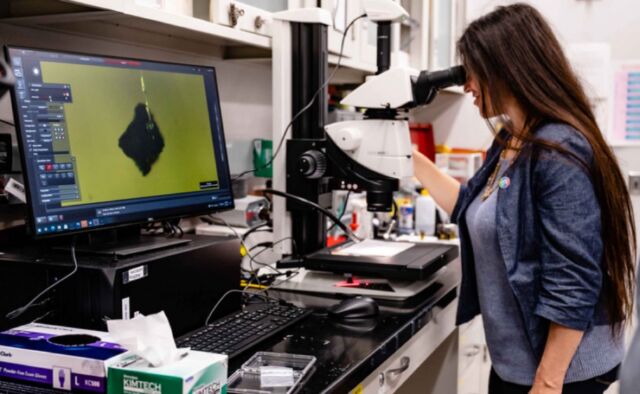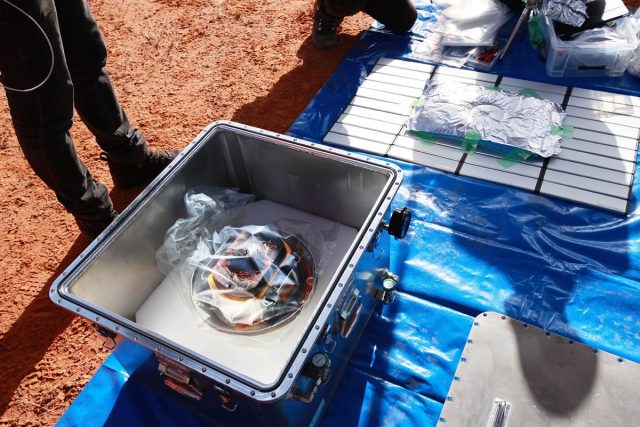Asteroid Ryugu was once part of a much larger parent body, new results find
Hayabusa2 returned to Earth with soil samples from the asteroid in December 2020
JENNIFER OUELLETTE

Enlarge / First spotted by astronomers in May 1999,
The Japanese spacecraft Hayabusa2 returned to Earth in December 2020 bearing soil samples collected from a nearby asteroid, 162173 Ryugu. Those samples were divided between six scientific teams around the world for cutting-edge analysis to determine their composition in hopes of learning more about how such bodies form. The results of the first year of analysis of those samples appeared in a new paper published in the journal Science and included the detection of a precious drop of water embedded in a crystal.
These findings suggest that Ryugu was once part of a much larger asteroid that formed out of various materials some two million years after our Solar System (some 4.5 billion years ago). Over the next 3 million years, the parent body's carbon dioxide ice melted, resulting in a water-rich interior and a drier surface. When another space rock hit the parent body about a billion years ago, it broke apart, and some of the resulting debris formed Ryugu. An accompanying computer simulation supports this formation history, backed by the results of the sample analyses.
First spotted by astronomers in May 1999, Ryugu is essentially a large collection of loose rubble. As much as 50 percent of its volume could be empty space. Like the asteroid Bennu, Ryugu is shaped a bit like a spinning top: a round shape with a sharp equatorial ridge. Its name derives from a Japanese folktale in which a fisherman travels to an underwater palace called Ryūgū-jō ("dragon palace") on the back of a turtle.
JAXA
Hayabusa2 has been in space since 2014, and it slowly made its way to an orbit 20 km above the surface of the asteroid Ryugu. In late 2018, the spacecraft made a close approach to the asteroid and released two small, solar-powered robots that hopped around on the surface. One of those was called MASCOT, the Mobile Asteroid Surface Scout. Despite landing upside-down, the robot eventually jumped into the right orientation. MASCOT's camera, a magnetometer, a radiometer, and an infrared spectrometer also sent back images to give scientists some sense of the materials around it and associate their properties with specific rocks. As Ars Science Editor John Timmer reported in 2019:
The first was darker and rough, with a surface appearance the researchers describe as "cauliflower-like." The second was brighter and had smoother surfaces and more angular shapes.... The Hyabusa2 team suspects that the features of the two different materials are the product of the heating/cooling cycles that take place as the rocks are exposed first to sunlight and then to the darkness of space. In some cases, this leads to the shattering of the rock, producing the smoother surfaces seen among some of the materials. In others, the rock slowly disintegrates, losing its internal structure and producing the other rocks observed by MASCOT.
The weird thing about that, however, is that crumbling and shattering rocks typically produce dust and sand-like materials. Yet there were no signs of any of this... They assume the smaller grains are either lost to space or end up working their way into the interior of the rubble. But the rocks that could be seen by MASCOT were all tens of centimeters across or larger (some were tens of meters).
Hayabusa2 collected surface samples by snuggling up to the asteroid and shooting it. The probe had a sample-gathering "horn," which was placed against the asteroid's surface. Then Hayabusa2 fired a bullet into the asteroid's surface, blasting material loose that was gathered by the horn and stored for return to Earth. Hayabusa2 also carried a heavier bullet intended to blast off the surface material to expose material that has remained protected for billions of years. A capsule containing the capsules landed in Australia in December 2020.
Last month, one team of researchers published the results of their analysis of dust samples from Ryugu in The Astrophysical Journal Letters, concluding that some of those grains of dust are older than our Solar System. The age of the grains in their dust can be identified and dated by their isotopic signatures, and the team compared the Ryugu dust samples to grains found in carbonaceous chondrite meteorites that have been found on Earth. The Ryugu dust sample held grains identical to others that have been seen in some of those meteorites that predate our Solar System.

Enlarge / UChicago and Argonne beamline scientist Barbara Lavina observes one of the tiny asteroid fragments through a microscope, with the magnified image on the screen beside her.
Jason Creps/Argonne National Laboratory
This latest paper adds to those results to reveal even more of Ryugu's secrets. For instance, co-author scientists at Argonne National Laboratory used the ultra-bright X-ray beams of the Advanced Photon Source to determine the chemical and structural makeup of Ryugu samples at the atomic scale. (The samples are tiny, between 400 microns to 1 millimeter in diameter, but the beamline can be focused to 15 microns.)
That analysis showed a porous, fine-grained structure shared by all the samples and a chemical makeup similar to rare Cl chondrite meteorites that have hit the Earth. That porosity indicates the asteroid once held water and ice, while the grains that make up Ryugu are much finer than one would expect if it had formed at higher temperatures—in keeping with the prevailing hypothesis that the asteroid formed in the outer reaches of the Solar System. There was also a large amount of an iron sulfide called pyrrhotite, which was not found in the meteorite samples used for comparison.
“Our results and those from other teams show that these asteroid samples are different from meteorites, particularly because meteorites have been through fiery atmosphere entry, weatherization, and in particular oxidation on Earth,” said co-author Michael Hu, a physicist at Argonne. “This is exciting because it’s a completely different kind of sample, from way out in the Solar System.”
Meanwhile, co-authors from Goethe University Frankfurt used synchrotron radiation-induced X-ray fluorescence computer tomography (SR-XRF-CT) on 16 sample particles from Ryugu. The presence of a fine vein of the iron oxide magnetite and a phosphate mineral called hydroxyapatite is in keeping with the asteroid forming at a surprisingly low temperature of less than 40° Celsius. The German team also picked up traces of rare earth metals at significantly higher concentrations than elsewhere in the solar system. The fact that those metal concentrations are equally distributed indicates that Ryugu "is a very pristine asteroid that represents the beginnings of our solar system," according to co-author Frank Brenker.
Perhaps the most intriguing finding: a drop of carbonated water (trapped in a crystal) containing salt and organic matter in samples from Ryugu. That's consistent with a hypothesis that asteroids like Ryugu may have brought water to Earth and helped seed the origin of life. Additional analytical results from the samples will be published in later papers and will eventually be compiled into a summary of the collective key findings.
DOI: Science, 2022. 10.1126/science.abn8671 (About DOIs).
Asteroid Ryugu is made of rubble from the outer solar system

The Japanese spacecraft Hayabusa2 is hard at work dislodging and then collecting samples from asteroid Ryugu in this artist's concept.
Early in the morning on Dec. 6, 2020, JAXA’s Hayabusa2’s sample-return capsule streaked through the sky over Woomera, Australia. The heat-shielded capsule, packed with material blasted from the surface of asteroid Ryugu in 2018, descended toward the desert sand. After tracking the precious cargo to its landing site, scientists successfully recovered the most pristine samples ever obtained of a carbon-rich asteroid.
Scientists have begun analyzing the samples. In one recent study published Aug. 15 in Nature Astronomy, researchers discovered the first evidence that Ryugu formed from material that originated in the outer solar system. The results also support the idea that the asteroid belt (located between Mars and Jupiter) may have been populated by planetesimals from two distinct sources when the solar system was still in its infancy.
“When I obtained the initial results from my instruments, I could not believe it,” Motoo Ito, a cosmochemist at the Japan Agency for Marine-Earth Science and Technology and lead author of the latter study, tells Astronomy.
Diving deep into asteroid dust
When Ito and his colleagues cracked open and analyzed the Ryugu particle samples, they found higher abundances of heavier hydrogen and nitrogen isotopes than what is typically seen on Earth and in meteorites. Ito analyzed the sample several times using different approaches to confirm the results.

Ito’s team found that Ryugu has a composition similar to that of carbonaceous chondrite (CC) meteorites. Such objects have not experienced extensive heating, and hence are believed to have formed farther out in the solar system, beyond the orbit of Jupiter.
Carbonaceous chondrites are relatively rich in carbon and organic materials, and they contain minerals with chemically bound water, which indicates they originally contained water-ice. Non-CCs, on the other hand, are thought to have originated closer to the Sun, where temperatures would have vaporized any volatiles like water, leaving behind primarily silicate materials.
“The evidence from this study is the strongest we have so far that asteroids came from two different reservoirs,” says planetary scientist Bojan Novakovic of the University of Belgrade in Serbia, who was not involved in the study.
Some previously analyzed meteorites and interplanetary dust particles also show evidence of being from the outer solar system, but the Ryugu sample is the most pristine example recovered to date. That’s because the extraterrestrial material didn’t have to tear through our atmosphere to get to Earth — at least not unprotected.
“Exposure to the terrestrial environment is a problem,” says Ito. “The atmosphere is full of water and oxygen, and we are surrounded by organic material, so we have no idea which material is extraterrestrial.”
A cosmic trip
As for how far-flung carbonaceous chondrites ultimately ended up in the main asteroid belt, the most likely answer is that they were scattered inwards by the gas giants. Today’s solar system is well behaved, but early on, the orbits of the planets were likely migrating. The resulting gravitational interactions would have wreaked havoc on smaller bodies such as asteroids.
“Asteroids get a ‘kick’ if they have a close encounter with a planet,” says Novakovic.
Once in the main belt, the rubble from numerous past asteroid collisions would have accreted to form new amalgamated asteroids like Ryugu. Then, over time, weak but persistent thermal radiation forces, along with perturbations from Saturn’s gravity, would have nudged Ryugu even further inward, says Novakovic.
“Close encounters with Mars may have induced the final kick into near-Earth space,” he adds.
Ryugu’s journey may have happened relatively quickly in astronomical terms, perhaps tens of millions of years. Meanwhile, Hayabusa2’s round-trip journey took only seven years. That may have seemed long to researchers, but it’s a blink of the eye in cosmic terms.
“The first time I saw the sample in the chamber was surreal,” says Ito. “I had imagined for many years that these precious samples would arrive to conduct studies.”

No comments:
Post a Comment